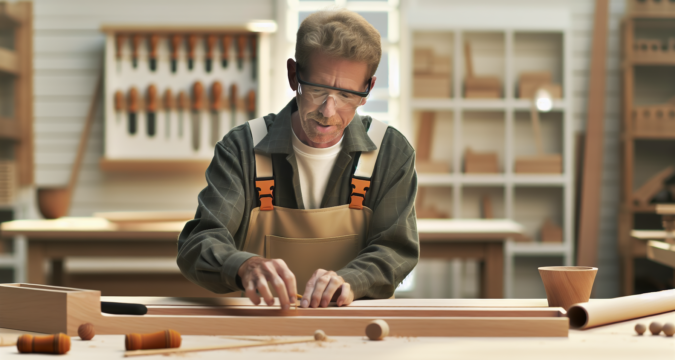
Finding Woodworking Inspiration in Contemporary Trends and Designs
Woodworking as a craft is evolving rapidly, with new trends bringing fresh inspiration to hobbyists and artisans alike. By looking at popular new styles and innovations, we can find exciting ways to stretch our creative wings with woodworking projects old and new. This article explores some of the most popular contemporary trends that can ignite new woodworking inspirations.
| Trend | Key Takeaways |
|---|---|
| Embracing Minimalism |
|
| Spotlight on Reclaimed Materials |
|
| Mixing Contemporary Materials |
|
| Finding Inspiration in Mid-Century Modern Style |
|
Embracing Minimalism
Over the last decade, minimalism has surged in popularity across home décor and furniture styles. The minimalism movement emphasizes simplicity, clean lines, and removing anything excessive or ornate.
There are several ways woodworkers can integrate minimalism into designs:
- Use neutral, lighter wood tones like maple, ash, and birch which appear more streamlined
- Avoid ornate wood carvings and details for a cleaner look
- Hide joinery with plugs or caps to create the illusion of seamlessness
- prioritize multifunctionality in pieces like storage beds or dining benches
-
use creative hidden storage like lift-top coffee tables or cabinets with recessed handles
When opting for a minimalist wood aesthetic, clean 90 degree design tends to take prevalence over rounded edges or pronounced grain patterns. Taking inspiration from Scandinavian or Japanese style minimalism yields beautiful results.
Spotlight on Reclaimed Materials
Sustainably sourcing reclaimed wood has become a priority for environmentally-conscious woodworkers. Rather than relying solely on fresh lumber from trees, reclaimed wood is salvaged from old barns, factories, or dismantled homes before it ends up in a landfill.
Wood reclaimed from old structures develops rich character over decades of use. Time and exposure impart desirable textures like oxidation, light cracking, or faded patinas which would be difficult to artificially reproduce. The resulting surfaces showcase wood’s natural history.
“Each reclaimed board has a soul and story uniquely its own, which no fresh-cut wood can replicate.” – Amanda Winter, Charm & Character
Beyond uniquely aesthetic traits, using reclaimed materials means diverting wood waste from landfills and giving it new life. This eco-conscious full-circle approach has made reclaimed wood more popular than ever before.
When looking for reclaimed stock, check sites like Craigslist and Facebook Marketplace along with demolition contractors and salvage depots. Once sourced, use the wood judiciously for accents, live edges, table tops, and shelving.
Mixing Contemporary Materials
Wood possesses an unmatched warmth and organic beauty. This natural appeal is prompting creative contemporary combinations with other sleek or industrial materials:
- Pairing rich wood with Cold grey concrete adds alluring visual contrast
- Weaving splits of black ebonized oak into maple builds modern drama
- Combining iron fixtures or steel legs with solid walnut slabs shows complements
Blending wood with stone, acrylic, glass or even epoxy resin allows for great flexibility in modern designs. Experiment with integrating contrasting textures and colors for visually captivating results.
When mingling materials, pay special attention to structural joinery:
- Allow as much surface area contact as possible
- Accommodate different rates of expansion
- Choose hardware suited to each material
- Level surfaces appropriately before joining
Thoughtfully interfacing wood with unlikely counterparts yields personal showstopper pieces that feel signature rather than mass produced.
Finding Inspiration in Mid-Century Modern Style
Mid-Century Modern style, poplarized between the 1930’s to 1960’s, has resurged in recent years. Hallmarks of the style include:
- Clean simple lines and angles but rounded curves
- Natural and organic shapes and forms
- Reflective of modern efficient lifestyles
- Lighter wood tones and offbeat color pairings
- Bringing the outdoors symbolically indoors
Several iconic Mid-Century wood pieces provide inspiration like Eero Saarinen’s Tulip chairs or the molded ply Noguchi Table. Study shapes and themes from recognizable Mid-Century architecture like John Lautner’s cliffside Chemosphere mansion or Frank Lloyd Wright’s waterfalling buildings.
DIYers can recreate the style in a modern context through:
- Custom cut ply and lamination
- Bent laminations for curved forms
- Elevated tapered legs paired with simple slab materials
- Thoughtfully placed wood portals andCDS or planter boxes
- Conversation pit seating areas in living rooms
By blending clean lines with organic shapes and forms, woodworkers can find renewed inspiration from this symbolic post-war era style even today.
Conclusion
The realm of woodworking inspiration is broader than ever before thanks to contemporary influences. From serene minimalism to reclaimed rusticity, blended materials to Mid-Century throwbacks, there is no shortage of modern muses to ignite our creativity for wood projects moving forward.
As new trends emerge, continue expanding horizons. Browse sites like Pinterest, Dwell Magazine, and Instagram for what’s trending. What you envision today could become tomorrow’s most coveted style. Most importantly, keep challenging yourself with new inspirations while celebrating the limitless beauty of wood.
Frequently Asked Questions
Where can I find reclaimed wood materials? Check demolition sites, salvage depots, Habitat for Humanity ReStores, and online classifieds like Craigslist and Facebook Marketplace. Networking with contractors in construction or deconstruction can provide referrals too.
What woods work best for Mid-Century designs? Walnut, teak and oak suit Mid-Century aesthetics well for their marbling and light tones as do quality plywood with laminated bends. Avoid very dark stains or ornate wood details to remain true to the style’s clean simplicity.
How do I join wood with metal or concrete? Use ample bolts lagged into pre-drilled holes and hardy construction adhesive at the joint. Consider anchors or angle brackets to reinforce connections and rubber washers to absorb materials expanding/contracting at different rates.
External Links:
Latest Woodworking Style and Design Trends
Tips for Joining Mixed Materials in Woodworking Projects | Make:

